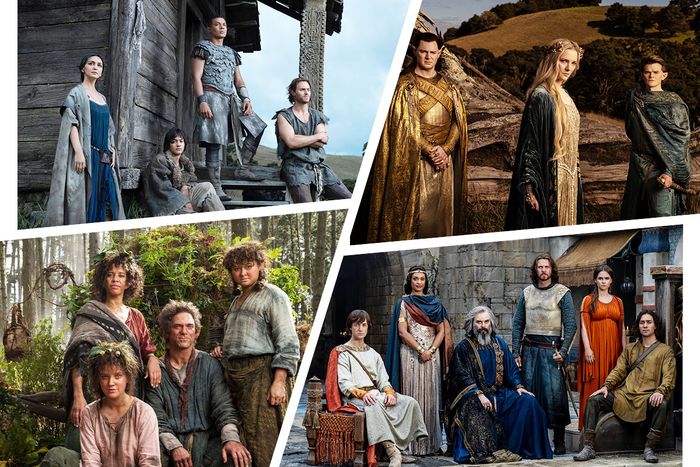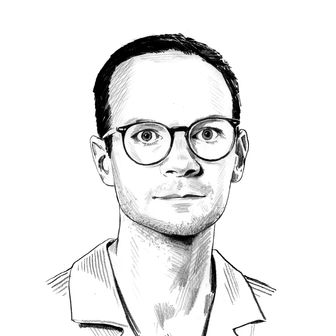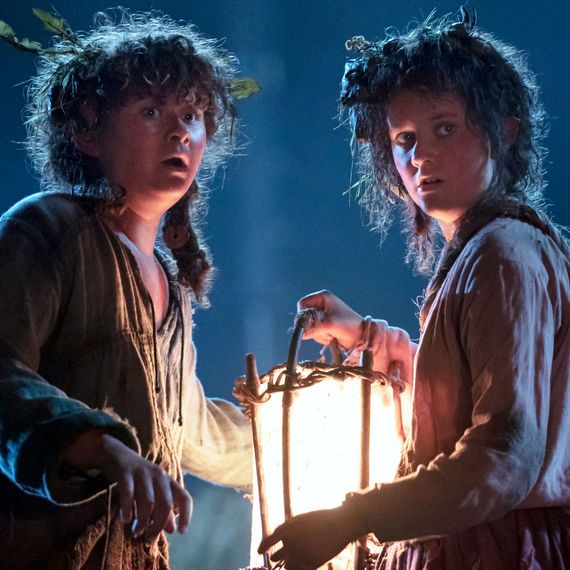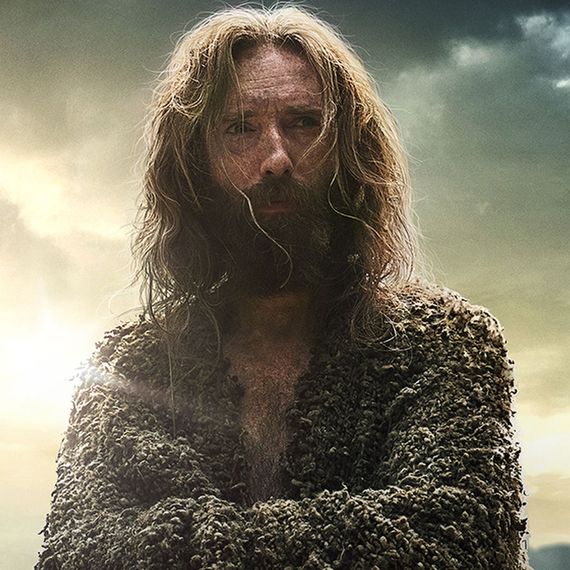
There’s a lot in the Lord of the Rings books you might skip over if, say, you’re barreling through to see what Frodo’s going to do with the Ring of Power — digressions and songs about the history of Middle-earth, prologues about the nature of Hobbits, and appendixes listing the succession of kings thousands of years before the main action. This fall, Amazon is premiering an eight-episode, half-billion-dollar first season of a TV series based on all the material in the margins of J.R.R. Tolkien’s fantasy series.
The Rings of Power, created by Patrick McKay and J.D. Payne, focuses on the major events of the Second Age of Middle-earth, a largely unexplored part of the history of Tolkien’s world that you can read about primarily in the appendixes of the Lord of the Rings trilogy. (Appendix B offers a slim timeline of the major events of the era, which leaves room for televisual reinterpretation; the series also compresses events for ease of adaptation.) After Amazon bought the rights to The Fellowship of the Ring, The Two Towers, The Return of the King, The Hobbit, and their appendixes, McKay, Payne, and producer Lindsey Weber proposed striking out from the better-known aspects of the story. Their development process was a bit like studying a religious text: They welded together a narrative from heavy close reading, deduction, and in cases where the text is silent, careful, Tolkien-scholar-supported flights of fancy. There are millenia-younger versions of a few characters you’ll recognize and locales the Middle-earth savvy will be thrilled to see come to the screen as well as characters and plots that are entirely invented.
The process might sound a bit like making a whole pie using just the peel of an apple, but the show quickly swelled into an epic. “Having enough was never the problem,” Weber said. “It was the other way around: There’s a boundless sea of imagination here.”
The Source Material
All Lord of the Rings and Hobbit books and film adaptations take place during a period called the Third Age — a time when the Dark Lord Sauron is plotting his comeback by tracking down his lost One Ring, which has fallen into the unlikely hands of the Hobbits.
The Rings of Power takes place during the Second Age, which begins with a cataclysmic battle between the Elves and Morgoth, the original, Lucifer-esque big bad of the Tolkien universe; as the era progresses, his lieutenant Sauron rises to power. The TV series picks up with the Elves complacent in their initial victory against Morgoth and the human and Dwarf kingdoms at the heights of their splendor, though they remain on uneasy terms with the haughty Elves, who are especially suspicious of the humans’ corruptible tendencies.
We know Sauron eventually emerges and tricks the Elves into creating the Rings of Power, using the Dwarves’ precious mithril as part of the process. We also know he’s nearly successful, but the Second Age ends with Sauron’s first — and incomplete — defeat at the hands of the “last alliance of Elves and men.” “People will know a few of the big things that will happen,” Payne said. “But we’re interested in how these characters get there along the way. What were the small grains of sand that tipped the scales?”
As they developed their pitch, McKay, Payne and Weber combed through the books, searching for details about the events of the Second Age. You hear Gandalf describe the story of the making of the rings to Frodo early in Fellowship of the Ring and Elrond retell it at a council in Rivendell. Sam includes it in a song about the fall of Elven king Gil-galad, which he sings when the Hobbits are early in their journey. “It’s like piecing together these clues,” McKay said. As they worked through possible plotlines for the series on a whiteboard, they realized a show winding through Middle-earth and leading up to that alliance had the epic emotional heft they needed. “There were these huge themes about fear of death, the temptation of evil, and even friendship,” McKay said. “I remember saying, ‘That’s the show.’”
“Tolkien talked about not creating Middle-earth but excavating it. We felt like we were discovering things that were already there,” Payne added. “People have heard about it in montages and flashes, but these are massive untold stories.”
The Main Characters
1.
Galadriel (Morfydd Clark)
Cate Blanchett played the older version of the Elven royal in the LOTR movies. Whereas that Galadriel was regal and reserved, Clark’s version is younger and angrier. She’s obsessed with hunting down Sauron even though most of her compatriots don’t believe he’s still out there.
➼ The source: The inspiration for Galadriel’s fixation on Sauron came from chapter seven of Fellowship, in which Galadriel says to Frodo, “I perceive the Dark Lord and know his mind.” Then there’s the etymology of her name, which means “crowned with a garland of radiance” in the Elven tongue. According to Tolkien’s letters, that’s because she put her hair up while sparring as a kid. “We thought, Let’s explore the warrior part of her,” Payne said.
2.
Nori Brandyfoot (Markella Kavenagh) and Poppy Proudfellow (Megan Richards)
There are no Hobbits in The Rings of Power — in the Tolkien canon, they don’t have much significance until Bilbo and Frodo Baggins show up, which is what makes them such unexpectedly good agents against Sauron. But if you’re making a Lord of the Rings series, people want to see something like Hobbits, so the show focuses on the Harfoots, a nomadic group of Hobbit-like halfling ancestors who roamed west during the Second Age.
The main Harfoot characters are Nori Brandyfoot, who dreams of adventure, and her supportive but less confident friend Poppy Proudfellow. Together, they have a Frodo-and-Sam-like dynamic.
Ramsey Avery, the show’s production designer, designed a village for the Harfoots built of structures that can be collapsed and taken on the go and would seem familiar enough to the depictions of Hobbits we’ve seen elsewhere. In the films and Tolkien’s writing, Hobbits have round doors, so the Harfoots use a lot of large wheels. “At some point, they’ll settle down, look at those wheels, and go, ‘Let’s make that a door,’” said Avery.
➼ The source: The description of the Harfoots comes primarily from the part of the prologue of The Lord of the Rings titled “Concerning Hobbits.” There, the Harfoots are mentioned among two other ancestor halfling groups known as Stoors and Fallohides. Compared to them, the Harfoots are “browner of skin, smaller, and shorter, and they were beardless and bootless; their hands and feet were neat and nimble; and they preferred highlands and hillsides.”
3.
The Stranger (Daniel Weyman)
In the first episode of The Rings of Power, a mysterious bearded man falls into a crater in the midst of Middle-earth. He has no idea who he is, but he’s connected to something important to come.
➼ The source: The creators aren’t explaining more about the Stranger, but say they always had the idea for a mysterious being dropping from the sky. He appears at first glance to be a whole-cloth creation, though his entrance mirrors that of other in-universe legends. “Tolkien’s always writing about the stars,” McKay said. “Eärendil becomes a star. Bilbo sings a song about the man on the moon coming down to earth. This felt like a branch of that tree.” Could the stranger be one of the Maiar, some of whom became Istari, the Middle-earth versions of wizards? Could he be Gandalf? There is certainly something magical about him.
4.
Elrond (Robert Aramayo)
In the books and films, Elrond is a half-Elven leader who plays a big part in organizing the Fellowship of the Ring and acts as the stern father to Arwen. In The Rings of Power, the young Elrond is still uptight, wary of his friend Galadriel’s exploits, and eager to impress the Elven king, Gil-galad (Benjamin Walker).
➼ The source: Elrond talks about himself plenty across The Lord of the Rings, especially during the chapter “The Council of Elrond,” in which he gets into the specifics of how Sauron coerced the Elves into making the Rings of Power through their “eagerness for knowledge.” At the outset, the show explores this through Elrond’s complex friendship with the Dwarf prince Durin IV, who, as we know from the appendixes, is one of six identical-looking Durins descended from each other.
5.
Bronwyn (Nazanin Boniadi) and Arondir (Ismael Cruz Cordova)
There’s a thread of The Rings of Power set in the southern part of Middle-earth, where the Elves and humans are in constant tension — and the human healer Bronwyn and Elf patroller Arondir fall in love. “We liked the idea of a Romeo and Juliet forbidden love,” Payne said, pointing out that the LOTR films already explored the romance of the human Aragorn and the Elf Arwen. “We’ve seen the human man with an Elf woman. What if we invert that?”
➼ The source: These two are entirely invented. There’s a reference in the appendixes to the difficulties of human-Elf relationships with regards to Aragorn and Arwen’s courtship, but Arondir and Bronwyn are their own thing. The mutual suspicion between Elves and humans in the Southlands is based on the fact that many humans fought for Morgoth in the previous era, and they feel suffocated by the patrolling Elves. “The thing that put all the different themes of the show together was the shadow of the war against Morgoth,” director J.A. Bayona said. “Everything is based on the relationship of each kingdom to that war.”
The New Worlds
The Rings of Power takes us to worlds that have not yet appeared onscreen but may be familiar to those who’ve read Tolkien closely. Like the places depicted in Peter Jackson’s films, The Rings of Power’s cities were created on location in New Zealand.
At home with the Dwarves in Khazad-dûm. In The Fellowship of the Ring, the characters travel through the abandoned Mines of Moria. Back in the Second Age, this place was known as Khazad-dûm, a thriving Dwarf community and home to their mining operations. In The Rings of Power, we see the splendor of that empire before it collapsed when the Dwarves dug too deeply. The series portrays a warmer, cozier side to the Dwarves than seen in the films, and introduces a major female Dwarf character, Princess Disa (Sophia Nomvete). In the appendixes, Tolkien notes there’s a common myth that female Dwarves don’t exist because they don’t travel abroad much and look a lot like male Dwarves.
Númenor, a.k.a. Tolkien’s Atlantis. Tolkien writes about a legendary human kingdom on its own island that, by the Third Age, has sunk into the ocean. The Rings of Power builds Númenor in all its splendor: Avery, the production designer, incorporated elements of Greco-Roman architecture into the city as well as canals in reference to a Tolkien correspondence in which he offhandedly compares the city to Venice. Some designs were their own invention: “We came up with a specific Númenorian bottle-arch form that we used a lot,” Avery said, “and a specific column shape different from any historical reference.” Nothing Doric, Ionic, or Corinthian here.
Valinor, Elven paradise. Also known as the Undying Lands, this is a peaceful realm across the sea to the west of Middle-earth where the Elves originated. It’s also where they sail to after leaving Middle-earth, as seen in The Return of the King. The Rings of Power starts with a flashback to Galadriel’s youth there, offering a glimpse of the trees Laurelin (the sun) and Telperion (the moon) before Morgoth destroyed them. These events are touched on in the appendixes of The Lord of the Rings and described in detail in The Silmarillion, Tolkien’s giant compendium of myths and legends that largely focuses on the First Age, and also describes the fall of Númenor. Amazon doesn’t have the rights to The Silmarillion, so the creators of The Rings of Power could write material that “harmonizes” with the descriptions of events in The Silmarillion but neither directly adapts nor contradicts them. “We have to do a very delicate dance,” Payne said.










